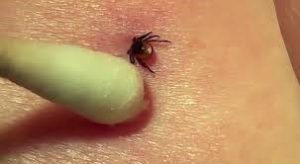Ticks are what is known as vectors – they themselves are not causes of disease, but they carry and transmit pathogens that can make your dog sick.
Ticks need to be attached and feeding, pumping their saliva into your pet, for 24-48 hours in order to transmit diseases such as Lyme disease, Anaplasmosis, and Ehrlichiosis. The keys to prevent transmission of disease are:
- For the diseases that have a vaccine, vaccinate (we can vaccinate for Lyme disease).
- Use a fast-kill tick preventive (such as Nexgard or Bravecto) – these make the ticks die and drop off before disease can be transmitted.
- Find and remove ticks after your dog has been outside – this gets the tick off the dog even faster than the tick preventive can do the job.
If you find a tick on your dog, there are a few options for removing it:
- Use tweezers or forceps; grip the tick’s head (not the body – squishing the tick just squeezes more “juice” into your dog) and pull slowly and gently perpendicular to the skin to remove the ticks mouthparts from their anchor-point in the skin. Do not pull across the skin, as you may leave the mouthparts behind to be an irritating foreign body.

- Use a Tick Twister (see diagram) – this has a part that goes between the tick’s head and the dog’s skin, so that you can turn the tick around and around and break the seal between the mouthparts and the skin. Once the seal is broken, the tick should come away easily.

- Use a homemade version of the Tick Twister – a wet cotton swab. Snug it up against the tick so that its legs tangle in the cotton, and start to twist – again the goal is to break the seal the mouthparts have made, so that the mouthparts come away cleanly.

What NOT to do:
- Do not burn the tick to make it let go
- Do not apply alcohol to make it let go
Both of these can cause a reaction in the tick where it “pukes” more of its juices into the dog.
Tick-borne diseases are on the rise here in Ontario – removing ticks is a step you can take to keep your dog healthy.
